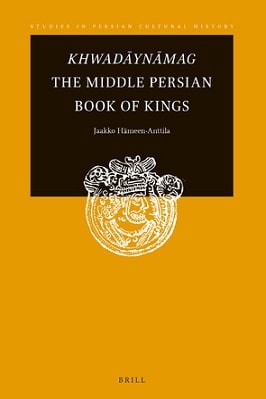
| Book Title | The Middle Persian Book Of Kings |
| Book Author | Jaakko Hämeen-Anttila |
| Total Pages | 294 |
| Book Views | |
| Language | English |
| Book Download | PDF Direct Download Link |
| Get Hardcover | Click for Hard Similar Copy from Amazon |
The Middle Persian Book of Kings – Khwadāynāmag – By Jaakko Hämeen-Anttila
THE MIDDLE PERSIAN BOOK OF KINGS
This book revolves around two questions: What was the Khwadāynāmag and how did it influence Arabic and Classical Persian historiography and epic literature? Before delving any deeper into these questions, a few preliminary issues have to be discussed.1
The Title Khwadāynāmag
The title Khwadāynāmag is used in scholarly literature for a lost Middle Persian historical work that was translated, among others, by Ibn al-Muqaffaʿ into Arabic.
Strictly speaking, the title is a reconstruction, which is not found as such anywhere in Middle Persian literature. It is based on the title Khudāynāme used in a few Arabic sources, often in forms corrupted by later scribes.
Our earliest source for the Arabic title is al-Masʿūdī’s Tanbīh, p. 106//150 (Khudāynāmāh). Ḥamza al-Iṣfahānī mentions the same book in his Taʾrīkh, p. 16: “Mūsā ibn ʿĪsā al-Kisrawī has said in his book: I looked into the book called the Khudāynāme, which is the book that, when translated from Persian into Arabic, is called Taʾrīkh mulūk al-Furs.” The same author also uses the title on pp. 22 and 50.
Likewise, Ibn al-Nadīm, Fihrist, p. 132/118//260, speaks about a Kitāb Khudāynāme fī l-siyar and in another passage, Fihrist, p. 305/245//589, mentions an Isḥāq ibn Yazīd, saying that “among what he translated was Sīrat al-Furs known as the *Khudāynāme”. Here the title has been variously distort-ed (ed. Tajaddud: ḤDʾD-nāme; ed. Flügel: Ikhtiyār-nāme;2 trans. Dodge follows Flügel), but the emendation is beyond doubt.3
These passages leave little doubt as to the Middle Persian title, and we find further support for this in early Classical Persian sources. Several versions of Persian national history in Classical Persian are titled Shāhnāmes.
In the Islamic period, the word khudāy in the sense “lord; king” fell into disuse, with a few exceptions.4
Bearing this in mind, Shāhnāme seems an exact translation of the Middle Persian Khwadāynāmag. This, however, does not mean that any of the Shāhnāmes from the tenth century or later was a translation of this book as such (Chapters 3.1 and 3.2).
All in all, it seems safe to use the Middle Persian title Khwadāynāmag. Whether the work also had a more elaborate title remains an open question.
What was the Khwadāynāmag?
The Khwadāynāmag, a central part of Persian national history, seems original to have been put down in writing in Middle Persian during the Sasanian period towards the end of the sixth century (Chapter 6.2).
Theodor Nöldeke’s (1879a: xiii–xxviii) brief comments on the Khwadāynāmag in the preface of his partial translation of al-Ṭabarī’s Taʾrīkh have been hugely influential in later literature, and a short exposition of his views offers us a good starting point.
Nöldeke (1879a): xiv–xv, drew attention to the similarity of the material in Firdawsī’s Shāhnāme and the Arab historians and deduced that as Firdawsī did not, as it seemed to him, use Arabic sources, the similarity must derive from the use of a common source.
This he took to be the old book, mentioned in the Bāysunqurī Preface.5 The latter is nowadays considered to be a late and unreliable source. Further, Nöldeke identified this with the Khwadāynāmag (“Dies Buch, das mit dem Chodhânâme zu identificieren wohl nicht zu kühn sein dürfte …”). As we shall later see, Nöldeke was, in fact, somewhat audacious in making this identification. Despite this, Nöldeke’s view has dominated to this day.
Nöldeke also compared various Arabic sources for pre-Islamic Persian history with each other and saw two basic storylines, one of which (represented by Ibn Qutayba, Eutychius, MS-Sprenger, and parts of al-Ṭabarī) he took to represent a direct line from Ibn al-Muqaffaʿ’s translation of the Khwadāynamag,
To read more about the The Middle Persian Book Of Kings book Click the download button below to get it for free
Report broken link
Support this Website
Click here to join our Telegram group for new Books
